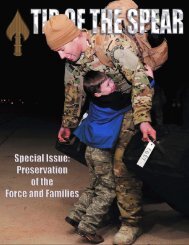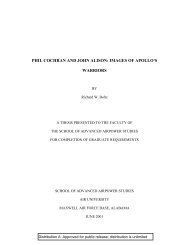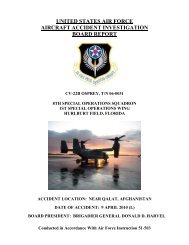Air Commando!: 1950-1975 - Twenty-five years at the Tip ... - AFSOC
Air Commando!: 1950-1975 - Twenty-five years at the Tip ... - AFSOC
Air Commando!: 1950-1975 - Twenty-five years at the Tip ... - AFSOC
You also want an ePaper? Increase the reach of your titles
YUMPU automatically turns print PDFs into web optimized ePapers that Google loves.
"Knife" H-53 lands in North Vietnam in<br />
1971 to extract sixteen fully armed<br />
"defectors" (to right of helicopter) guarded<br />
by one "friendly"; <strong>the</strong> o<strong>the</strong>r guard having<br />
been killed by <strong>the</strong> same defectors <strong>the</strong><br />
night prior to pick-up. Although pick-up<br />
was organized by American sources on<br />
<strong>the</strong> ground, one miscue on ei<strong>the</strong>r side<br />
could have lead to an instantaneous<br />
bloodb<strong>at</strong>h for everyone in <strong>the</strong> clearing.<br />
(Jerry Gilbert)<br />
exceptions. In January, 1970 for<br />
example, <strong>the</strong> 21st was again tasked to<br />
evacu<strong>at</strong>e Laotian refugees, this time<br />
from <strong>the</strong> Plain of Jars, where <strong>the</strong>y had<br />
been encircled by communist troops.<br />
From 4-15 January, <strong>the</strong> 21st moved<br />
more than 4,000 refugees, along with<br />
<strong>the</strong>ir livestock and belongings, to<br />
safety. 170<br />
In August, 1970, CH-53C "Super<br />
Jolly Green Giant" helicopters began<br />
arriving to augment <strong>the</strong> b<strong>at</strong>tle-worn and<br />
underpowered H-3s. With <strong>the</strong> larger,<br />
more powerful choppers, <strong>the</strong> 21st began<br />
flying troop-carrying missions in<br />
airmobile assaults, primarily supporting<br />
Laotian army and Yang Pao's Hmong<br />
irregulars. Three months after <strong>the</strong><br />
arrival of <strong>the</strong> "Super Jollys" in <strong>the</strong> 21st,<br />
its crews lifted 2,000 troops onto <strong>the</strong><br />
Plain of Jars in an offensive intended<br />
to drive <strong>the</strong> North Vietnamese and<br />
Laotian P<strong>at</strong>het Lao forces out. Codenamed<br />
Oper<strong>at</strong>ion Leapfrog, <strong>the</strong> mission<br />
was only a temporary success and by early 1971, <strong>the</strong> more heavily armed communist<br />
forces were back in force on <strong>the</strong> Plain. 171<br />
The last major air assault in Laos took place on 20 January 1973. Seven 21st CH-53s<br />
and two <strong>Air</strong> America CH-47s moved 1,000 Laotian troops in an oper<strong>at</strong>ion intended toreopen<br />
<strong>the</strong> highway between <strong>the</strong> Laotian capitol of Vientiane, and <strong>the</strong> city of Luang Prabang<br />
some 120 miles to <strong>the</strong> north. The assault successfully ended <strong>the</strong> isol<strong>at</strong>ion of Luang Prabang<br />
by <strong>the</strong> communists. 172 Just a month l<strong>at</strong>er, on 22 February 1973, missions by <strong>the</strong> 21st SOS<br />
(and all o<strong>the</strong>r allied forces) in Laos were ended by intern<strong>at</strong>ional agreement. The Laotians<br />
and <strong>the</strong> Hmong irregulars were on <strong>the</strong>ir own.<br />
The 21st remained in Thailand after <strong>the</strong> cease-fire and <strong>the</strong> subsequent U.S. withdrawal<br />
from South Vietnam in 1973. It was placed on alert for <strong>the</strong> evacu<strong>at</strong>ion of <strong>the</strong> Cambodian<br />
capitol, and assisted in <strong>the</strong> evacu<strong>at</strong>ion of Saigon as it fell to <strong>the</strong> communists in l<strong>at</strong>e April,<br />
<strong>1975</strong>.<br />
With <strong>the</strong> assistance of two <strong>Air</strong> Rescue Service HH-53s, <strong>the</strong> 21st evacu<strong>at</strong>ed 1,479 Americans<br />
and Vietnamese, as well as 249 U.S. Marines from <strong>the</strong> American Embassy in Saigon. They<br />
were l<strong>at</strong>er tasked to sling-load former South Vietnamese A-37 and F-5 fighters, flown by <strong>the</strong>ir<br />
pilots from Vietnam to Thailand to prevent <strong>the</strong>m from falling into communist hands, to <strong>the</strong><br />
aircraft carrier MU1way. 173 Scheduled for de-activ<strong>at</strong>ion in Thailand in September, <strong>1975</strong>, <strong>the</strong> 21st<br />
found it had one last mission to accomplish before retiring its colors.<br />
In early May of th<strong>at</strong> year, <strong>the</strong> Dust Devils particip<strong>at</strong>ed in <strong>the</strong> costly <strong>at</strong>tempt to rescue <strong>the</strong><br />
crew of <strong>the</strong> American container ship S.S. Mayaguez, captured in intern<strong>at</strong>ional w<strong>at</strong>ers by<br />
Cambodia's new rulers, <strong>the</strong> Khmer Rouge. While <strong>the</strong> crew were eventually released<br />
unharmed from <strong>the</strong> Cambodian mainland, <strong>the</strong> bloody <strong>Air</strong> Force and Marine Corps assault<br />
on Koh Tang Island, thought to be <strong>the</strong> loc<strong>at</strong>ion of <strong>the</strong> incarcer<strong>at</strong>ed crew, proved to be one<br />
last bloody nose for America as it closed down <strong>the</strong> curtain on <strong>the</strong> longest war in this<br />
country's history.<br />
92





